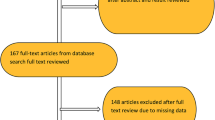Abstract
The incidence of regional lymph node metastasis in early Barrett's carcinoma is determined by the depth of infiltration of the tumour. The present study investigated the possible relationship between the depth of infiltration of the tumour, its degree of differentiation and the incidence of lymphatic vessel and venous invasion in early Barrett's carcinoma. To this end, a total of 805 endoscopically resected specimens obtained from 472 patients with early Barrett's carcinomas were analysed. The results of this analysis revealed that increasing depth of tumour infiltration is associated with an increase in the incidence of poorly differentiated carcinomas—from 0.8% for lesions limited to the mucosa (m1) to 41.4% when the depth of infiltration extended to the lower third of the submucosa (sm3). A similar correlation was also found for the incidence of lymphatic vessel invasion (m1, 0.6%; sm3, 44.8%) and for venous invasion (m1, 0%; sm3, 13.8%). All of these observations proved to be statistically highly significant (p < 0.001). In conclusion, the results show that the degree of differentiation, as well as the incidence of lymphatic vessel and venous invasion, correlates with the depth of infiltration of the early carcinoma in Barrett's oesophagus.



Similar content being viewed by others
References
Paraf F, Flejou JF, Pignon JP et al (1995) Surgical pathology of adenocarcinoma arising in Barrett's esophagus. Analysis of 67 cases. Am J Surg Pathol 19:183–191
Rice TW, Zuccaro G Jr, Adelstein DJ et al (1998) Esophageal carcinoma: depth of tumor invasion is predictive of regional lymph node status. Ann Thorac Surg 65:787–792
Ruol A, Merigliano S, Baldan N et al (1997) Prevalence, management and outcome of early adenocarcinoma (pT1) of the esophago-gastric junction. Comparison between early cancer in Barrett's esophagus (type I) and early cancer of the cardia (type II). Dis Esophagus 10:190–195
Stein HJ, Feith M, Mueller J et al (2000) Limited resection for early adenocarcinoma in Barrett's esophagus. Ann Surg 232:733–742
van Sandick JW, van Lanschot JJ, ten Kate FJ et al (2000) Pathology of early invasive adenocarcinoma of the esophagus or esophagogastric junction: implications for therapeutic decision making. Cancer 88:2429–2437
Buskens CJ, Westerterp M, Lagarde SM et al (2004) Prediction of appropriateness of local endoscopic treatment for high-grade dysplasia and early adenocarcinoma by EUS and histopathologic features. Gastrointest Endosc 60:703–710
Westerterp M, Koppert LB, Buskens CJ et al (2005) Outcome of surgical treatment for early adenocarcinoma of the esophagus or gastro-esophageal junction. Virchows Arch 446:497–504
Liu L, Hofstetter WL, Rashid A et al (2005) Significance of the depth of tumor invasion and lymph node metastasis in superficially invasive (T1) esophageal adenocarcinoma. Am J Surg Pathol 29:1079–1085
Vieth M, Ell C, Gossner L et al (2004) Histological analysis of endoscopic resection specimens from 326 patients with Barrett's esophagus and early neoplasia. Endoscopy 36:776–781
Werner M, Fléjou J, Hainaut P et al (2000) Adenocarcinoma of the oesophagus. In: Hamilton SR, Aaltonen LA (eds) World Health Organization classification of tumours: pathology and genetics of tumours of the digestive system. IARC Press, Lyon, pp 20–26
Wittekind C, Meyer J, Bootz F, International Union Against Cancer (UICC) (2002) TNM Klassifikation maligner Tumoren, 6. Auflage. Springer-Verlag, Berlin, pp 55–58
Japanese Society for Esophageal Diseases (2001) Guidelines for clinical and pathologic studies on carcinoma in the esophagus, 9th edn. Kanehara & Co., Ltd., Tokyo
Bortz J, Lienert G, Boehnke K (1990) Verteilungsfreie Methoden in der Biostatistik. Springer-Verlag, Berlin, pp 121–158
Bortz J, Lienert G (1998) Kurzgefaßte Statistik für die klinische Forschung: Ein praktischer Leitfaden für die Analyse kleiner Stichproben. Springer-Verlag, Berlin, pp 71–103, 122–139
Lehnert U (2000) Datenanalysesystem SPSS Version 9: handlungsorientiertes und leicht verständliches Lehrbuch zur Einführung in die statistische Datenanalyse, 3. Auflage. Oldenbourg Wissenschaftsverlag GmbH, München
Noguchi H, Naomoto Y, Kondo H et al (2000) Evaluation of endoscopic mucosal resection for superficial esophageal carcinoma. Surg Laparosc Endosc Percutan Tech 10:343–350
May A, Gunter E, Roth F et al (2004) Accuracy of staging in early oesophageal cancer using high resolution endoscopy and high resolution endosonography: a comparative, prospective, and blinded trial. Gut 53:634–640
Murata Y, Suzuki S, Ohta M et al (1996) Small ultrasonic probes for determination of the depth of superficial esophageal cancer. Gastrointest Endosc 44:23–28
Simizu Y, Tsukagoshi H, Nakazato T et al (1995) Clinical evaluation of endoscopic ultrasonography (EUS) in the diagnosis of superficial esophageal carcinoma. Rinsho Byori 43:221–226
Potet F, Flejou JF, Gervaz H et al (1991) Adenocarcinoma of the lower esophagus and the esophagogastric junction. Semin Diagn Pathol 8:126–136
Vieth M, Stolte M (2005) Pathology of early upper GI cancers. Best Pract Res Clin Gastroenterol 19:857–869
Acknowledgement
The authors are most grateful to Dr. Reinhard Wittenberg, from the Department of Sociology and Empirical Social Research, Nuremberg, Germany, for his valuable advice on statistical analysis.
Conflict of interest
The authors declare that they have no conflict of interest.
Author information
Authors and Affiliations
Corresponding author
Rights and permissions
About this article
Cite this article
Zemler, B., May, A., Ell, C. et al. Early Barrett's carcinoma: the depth of infiltration of the tumour correlates with the degree of differentiation, the incidence of lymphatic vessel and venous invasion. Virchows Arch 456, 609–614 (2010). https://doi.org/10.1007/s00428-010-0925-5
Received:
Revised:
Accepted:
Published:
Issue Date:
DOI: https://doi.org/10.1007/s00428-010-0925-5



